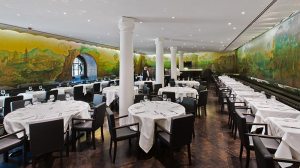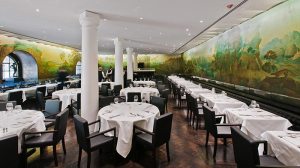Unlike Paris or New York, London has never really been sentimental about its restaurants. The former cities can brag of Belle Époque epicurean heritage and grand culinary traditions, but here in the Smoke, only a handful of establishments date back anywhere near the half-century mark. In recent years, though, rare has been the week in which some theatrical pseudo-brasserie has not opened to grand applause. Tate Britain’s recently-reopened Rex Whistler Restaurant, though, is the genuine article.
 First opened in 1927, the walls of the surprisingly well-lit basement space it occupies are famously covered with the eponymous artist’s The Expedition in Pursuit of Rare Meats. Whistler was just 23 and only recently out of training at the Slade School of Art when he completed it, and possessed of an artistic identity that had much in common with the other ‘British Moderns’ of the era but was very much his own. The mural depicts a hunting party setting out from a Palladian villa into a landscape of crenelated fortresses, stacked pagodas and preposterously lumpy hills – ‘it’s a whimsical scene typical of the work produced by the ‘Bright Young Things’ of the era,’ as art historian, antique dealer and food writer Luke Honey tells me.
First opened in 1927, the walls of the surprisingly well-lit basement space it occupies are famously covered with the eponymous artist’s The Expedition in Pursuit of Rare Meats. Whistler was just 23 and only recently out of training at the Slade School of Art when he completed it, and possessed of an artistic identity that had much in common with the other ‘British Moderns’ of the era but was very much his own. The mural depicts a hunting party setting out from a Palladian villa into a landscape of crenelated fortresses, stacked pagodas and preposterously lumpy hills – ‘it’s a whimsical scene typical of the work produced by the ‘Bright Young Things’ of the era,’ as art historian, antique dealer and food writer Luke Honey tells me.
Looking at the mural now is a strange experience; while its subject matter and frivolously gallant style are almost unutterably camp, there’s a sombre sobriety to the tones of the paint that renders it an impressive work rather than the sort of kitsch and ephemerally fashionable diorama churned out by some of his contemporaries. As part of Tate Britain’s astonishing recent refurbishment, The Expedition in Pursuit of Rare Meats has been cleaned up and rid of the yellow sheen it developed after years of exposure to fag-smoking customers. Now over 80 years old, it very nearly didn’t even make it to its first birthday; when the Thames flooded in 1928, the mural survived due to the mixture of oils and wax Whistler used to paint it.
 The artist himself wasn’t so lucky – Whistler, who had gone on to paint many more Arcadian murals in grand houses as a result of the Tate commission, was killed in France shortly after the D-Day landings. The tragedy was made all the more acute by the fact that his wartime portraiture had begun to take on a more serious and less obviously winsome flair. Much of the fascination around him stems from the fact that works like his uniformed self-portrait of 1940 or The Master Cook of 1941 suggest an artist on the brink of a major stylistic breakthrough.
The artist himself wasn’t so lucky – Whistler, who had gone on to paint many more Arcadian murals in grand houses as a result of the Tate commission, was killed in France shortly after the D-Day landings. The tragedy was made all the more acute by the fact that his wartime portraiture had begun to take on a more serious and less obviously winsome flair. Much of the fascination around him stems from the fact that works like his uniformed self-portrait of 1940 or The Master Cook of 1941 suggest an artist on the brink of a major stylistic breakthrough.
Despite a new menu serving a ‘1920s cuisine’, the restaurant named in his honour has, aesthetically at least, remained more or less unchanged. This is as it should be – it’s not the sort of place you forget visiting. Historically, it has been a perfect vantage point for watching politicians or art world celebrities working their way through its famous wine list. I remember being taken by my parents at some point in the late 1990s; we sat in silence as Nicholas Serota entertained a group of important-looking men in suits at the next table. It was the extraordinary atmosphere of the room and its bizarre mural, rather than the eavesdropping opportunities that kept us quiet.
The Whistler Restaurant is open daily at Tate Britain for lunch (12.00–15.00) and for dinner on the first Friday of every other month (February 2014, April, June etc, 18.00–21.30).

Lunch with Rex Whistler
Share
Unlike Paris or New York, London has never really been sentimental about its restaurants. The former cities can brag of Belle Époque epicurean heritage and grand culinary traditions, but here in the Smoke, only a handful of establishments date back anywhere near the half-century mark. In recent years, though, rare has been the week in which some theatrical pseudo-brasserie has not opened to grand applause. Tate Britain’s recently-reopened Rex Whistler Restaurant, though, is the genuine article.
Looking at the mural now is a strange experience; while its subject matter and frivolously gallant style are almost unutterably camp, there’s a sombre sobriety to the tones of the paint that renders it an impressive work rather than the sort of kitsch and ephemerally fashionable diorama churned out by some of his contemporaries. As part of Tate Britain’s astonishing recent refurbishment, The Expedition in Pursuit of Rare Meats has been cleaned up and rid of the yellow sheen it developed after years of exposure to fag-smoking customers. Now over 80 years old, it very nearly didn’t even make it to its first birthday; when the Thames flooded in 1928, the mural survived due to the mixture of oils and wax Whistler used to paint it.
Despite a new menu serving a ‘1920s cuisine’, the restaurant named in his honour has, aesthetically at least, remained more or less unchanged. This is as it should be – it’s not the sort of place you forget visiting. Historically, it has been a perfect vantage point for watching politicians or art world celebrities working their way through its famous wine list. I remember being taken by my parents at some point in the late 1990s; we sat in silence as Nicholas Serota entertained a group of important-looking men in suits at the next table. It was the extraordinary atmosphere of the room and its bizarre mural, rather than the eavesdropping opportunities that kept us quiet.
The Whistler Restaurant is open daily at Tate Britain for lunch (12.00–15.00) and for dinner on the first Friday of every other month (February 2014, April, June etc, 18.00–21.30).
Black Friday sale: 6 months for the price of 3
Subscribe using our Black Friday sale to get six months of the most incisive art writing available for the price of three.
Share
Recommended for you
Affordable Art
A new 50p piece, designed by Tom Phillips to celebrate the centenary of Benjamin Britten’s birth, attempts to ‘set the wild echoes flying’
New Year’s Revelations
Limerick’s first week as Ireland’s City of Culture has been a deliciously absurdist shambles as both the artistic director and CEO resign